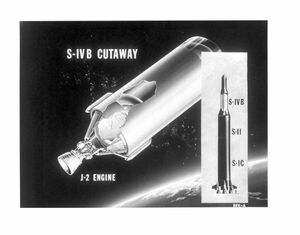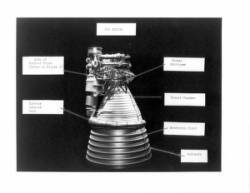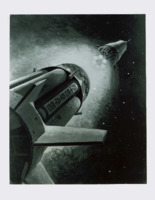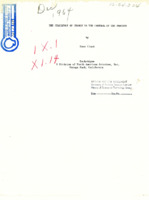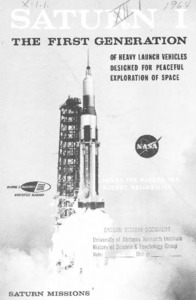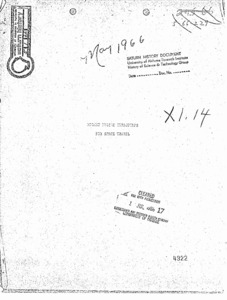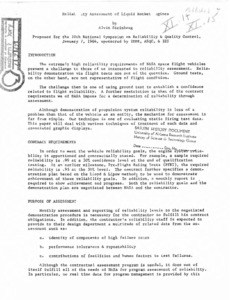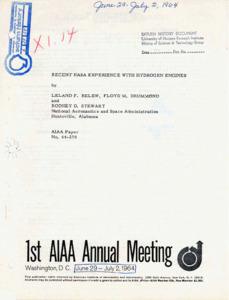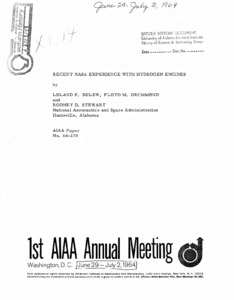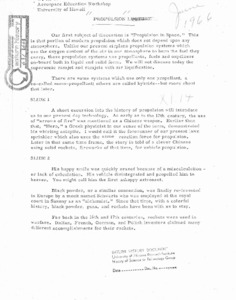
Browse Items (20 total)
Sort by:
-
S-IVB cutaway and J-2 engine."
8 x 10 inch black and white diagram of the JII engine and the Saturn IV. -
F-1 engine photograph.
8 x 10 inch black and white photograph. Engine parts are labeled. -
Artist's Conception of the RL10-powered Saturn S-IV Stage.
This artist's rendering of the RL10-powered Saturn S-IV stage is depicted as heading toward deep space after separation from the booster. The drawing is accompanied with a brief description of the Saturn S-IV. -
"The Challenge of Change vs the Control of the Process."
The introduction states, "This paper is designed to present the Rocketdyne engine program as it applies to the Saturn launch vehicles and will apply to the Apollo program of manned flight to the moon (Fig. 1). The vehicle that will launch this flight is the Saturn V, the largest and most powerful of the Saturn family. This vehicle, 362 feet tall and 33 feet in diameter, will be capable of sending a 45-ton payload to the moon or placing a 120-ton payload in earth orbit. Five F-1 engines power the first stage of the Saturn V; five J-2 engines, the second stage; and one J-2 engine, the third stage. The thrust of the first-stage engines alone will be equivalent to 160 million horsepower. Both of these engines, the F-1 and the J-2, were designed at, and are currently being produced by Rocketdyne." -
"Saturn I : the first generation of heavy launch vehicles designed for peaceful exploration of space."
A basic description of the Saturn rockets alongside diagrams for context. -
"Rocket engine turbo pumps for space travel."
Finding the turbopump arrangement which is best suited for a given rocket engine - space travel applications - constitutes an important task. The arrangement depends upon a large variety of different factors, such as, the engine cycle, weight, the liquids to be pumped, the cavitation performance, the bearings and their lubrication, the seals and the turbine. In this report these factors and their influence on the turbopump configuration are discussed. It is shown that three of them: weight, propellants to be pumped and obtainable suction performance have the largest influence on the selection of the turbopump. A systematic approach is outlines for the design process, which allows to arrive at a turbopump arrangement best suited for a given application. -
"Reliability assessment of liquid rocket engines."
Proposed for the 10th National Symposium on Reliability & Quality Control. This paper will deal with various techniques of treatment of such data and associated graphic displays. -
"Recent NASA experience with hydrogen engines."
This paper presents a review of the experience which has accumulated in the development of the Liquid Hydrogen J-2 and RL10 rocket engines. These engines are being developed by the Rocketdyne Division of North American Aviation and Pratt & Whitney Aircraft, a Division of United Aircraft Corporation respectively.; On NASA Technical Reports Server (NTRS) as Unclassified; No Copyright; Unlimited; Publicly available. Also found on AIAA site. -
"Recent NASA experience with hydrogen engines."
This paper presents a review of the experience which has accumulated in the development of the Liquid Hydrogen J-2 and RL10 rocket engines. These engines are being developed by the Rocketdyne Division of North American Aviation and Pratt & Whitney Aircraft, a Division of United Aircraft Corporation respectively.; On NASA Technical Reports Server (NTRS) as Unclassified; No Copyright; Unlimited; Publicly available. Also found on AIAA site. -
"Propulsion lecture."
Lecture discussing the types of propellant used in space rockets.
